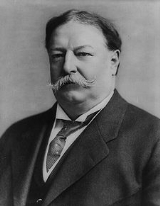
(1909–1913) and later the tenth Chief Justice of the United States
(1921–1930). He is the only person to have served in both offices, and along with James Polk, the only president to have also headed another branch of the federal government
with the exception of vice-presidents who went on to become president.
Born in 1857 in Cincinnati, Ohio, into the powerful Taft family
, "Big Bill" graduated from Yale College
as a Phi Beta Kappa in 1878 and from Cincinnati Law School in 1880.
We are all imperfect. We can not expect perfect government.![]()
I have come to the conclusion that the major part of the work of a President is to increase the gate receipts of expositions and fairs and bring tourists to town.![]()
I am in favor of helping the prosperity of all countries because, when we are all prosperous, the trade of each becomes more valuable to the other.![]()
I love judges, and I love courts. They are my ideals, that typify on earth what we shall meet hereafter in heaven under a just God.![]()
The intoxication of power rapidly sobers off in the knowledge of its restrictions and under the prompt reminder of an ever-present and not always considerate press, as well as the kindly suggestions that not infrequently come from Congress.![]()
The diplomacy of the present administration has sought to respond to modern ideas of commercial intercourse. This policy has been characterized as substituting dollars for bullets. It is one that appeals alike to idealistic humanitarian sentiments, to the dictates of sound policy and strategy, and to legitimate commercial aims.![]()
"State of the Union" (3 December 1912)
![]()

